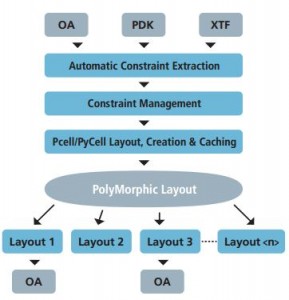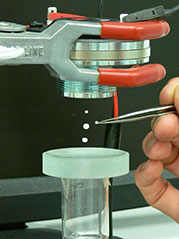Deadlines for health tech funding competitions
The deadlines for two health technology funding competitions in the SouthWest are approaching.
The telehealth competition run by the SW Microelectronics iNet and West of England Academic health Science Network (WEAHSN) closes on 4th July for expressions of interest for innovation vouchers worth up to £10,000
The competition is seeking applications from innovative small to medium-sized enterprises in the South West of England for telehealth projects focusing on the delivery of health-related products, processes and services via telecommunications technologies.
If you are interested, and would like to find out more information please email microelectronics@inets-sw.co.uk for the form.
The deadline to submit Expression of Interest form is Friday, 4th July. There is also a matchmaking workshop on Wed 16th July to put projects in touch with each other.
The latest competition from SBRI Healthcare, an NHS England-funded initiative to develop innovative products and services that address unmet health needs, has £2.5 million available to support small business development across England. Businesses will be able to submit applications for the competition from now until 12:00pm on 10 July 2014.
SBRI Healthcare will be working in partnership with the West of England and Wessex Academic Health Science Networks (AHSNs) on medicines adherence, which is one of the five key areas of healthcare that the national competition will focus on.
Businesses in the West of England are encouraged to submit products and services that will help improve how patients follow treatment recommendations to ensure that patients are getting optimum benefit from all the treatments they have been prescribed.
“It is estimated that between a third and a half of prescribed and dispensed medicines are not used as recommended and many end up being wasted,” said Sue Ladds, Chief Pharmacist, University Hospital Southampton NHS Foundation Trust. “This has a significant negative effect on patients, the healthcare system and society at large so it is imperative that we find an innovative patient-centred solution to reduce the non-adherence and suboptimal use of medicines.”
The SBRI initiative is a three-phased approach which starts with a six-month feasibility phase with an award of up to £100,000 and then moves on to more detailed product development and NHS validation, where companies can secure up to £2 million in funding support.
“The support we have received from SBRI and the West of England AHSN has been fantastic. We have been able to further the development around our handheld ECG monitory device which can be synced up to smartphones and PCs to help primary care and ambulance staff to identify arrhythmias,” said Steve Cliffe, Business Development Director, Plessey Semiconductors won the last SBRI competition earlier in the year
“We are really encouraging organisations to get involved as this is a fully-funded opportunity for businesses to access support to bring their innovative products and services to new markets,” said Dr Elizabeth Dymond, Deputy Director, Enterprise and Translation at West of England AHSN.
“We have partnered up with the West of England AHSN on this competition because we feel that this is a topic that businesses in our area could really contribute to, said Andy Burroughs Director of Wealth and Enterprise, Wessex AHSN.
Ensigma’s 802.11ac WiFi IP cores gain chip traction
There is growing market traction for the Ensigma Series4 ‘Explorer’ radio processor unit (RPU) cores designed in Chepstow as more companies integrate 802.11ac WiFi, Bluetooth 4.1 and other connectivity into their Systems-on-Chips (SoCs).
New customers for the Ensigma WiFi/Bluetooth combo IP cores from Imagination Technologies include Ineda, Toshiba, Toumaz and multiple fabless companies from Korea and China including Rockchip and others from around the world who will be announced publicly at a later time. Among the target applications are streaming media devices, tablets, wearables, IoT devices and standalone WiFi combo chips. The new Ensigma WiFi licensees join the growing Ensigma RPU customer base, which also includes Qualcomm, STMicroelectronics, S2-Tek, Frontier Silicon, Orca Systems and others.
“Moving forward, virtually every device will be connected,” said Martin Woodhead, EVP for Ensigma Communications at Imagination. “To address this, the Ensigma RPU offers the flexibility to design for a range of connectivity and broadcast standards using just one on-chip radio system, so customers can create one design for multiple markets and also have a built-in roadmap for emerging standards. With our end-to-end connectivity solutions including RF, baseband, firmware, software, support and certifications, Imagination is uniquely positioned to help customers address new market opportunities quickly and cost-effectively.”
Imagination has a graphics hardware and software design centre in Bristol as well as the radio design team in Chepstow. The company’s program of WiFi Alliance certifications ensures interoperability. Imagination has recently achieved WiFi Alliance certification for Miracast and Passpoint, adding to a growing list of certifications including WiFi CERTIFIED, WiFi Direct, WPA, WPA2, WMM and WiFi Protected Setup.
The Ensigma Series4 RPUs provide a unique universal and highly scalable solution for integrating global connectivity and broadcast communications capabilities into SoCs. By combining the latest software programmable radio techniques with a multi-processor architecture, a wide range of communications standards are fully supported. The flexible hardware architecture of Ensigma Series4 RPUs means that the engine can be easily scaled to address everything from the smallest most cost-sensitive embedded connected processors to the most advanced connected smart TVs and tablets targeting global markets.
Ensigma RPUs support all key standards for connectivity including 802.11a/b/g, 802.11n with up to 4×4 MIMO, 802.11ac with up to 2×2 MIMO, as well as Bluetooth. They also enable global TV products supporting DVB-T2, DVB-T, ISDB-T, ATSC, GB20600-2006 (CTTB), DVB-S2, DVB-S, ISDB-S, DVB-C, J.83B, ISDB-C; analogue TV; mobile TV including T-DMB, 1-Seg ISDB-T; and broadcast radio standards including DAB/DAB+, HD Radio, 3-seg ISDB-T, ISDB-Tmm and FM.
Related articles
CSR expands in Bristol with new R&D centre
Cambridge Silicon Radio (CSR) has opened a new Research and Development facility in Bristol to drive further innovation in WiFi technology.
The new site, opened today, is staffed by 33 engineers from a wide range of companies in the area such as ST, Nokia and Imagination Technologies and from all around the world, including India, Italy, Spain and the Czech Republic.
“We were building a WiFi team in Bristol but we needed a step change in capability,” said Joep van Buerden, CEO of CSR at the opening (below). “We had the opportunity to acquire the WiFi team lock stock and barrel from ST-Ericsson 16 months ago but then we discovered how good a place Bristol was. There is a steady supply of graduates from the university and leading companies around with a vibrant community of engineers with all sorts of expertise.”
Since the opening of CSR’s original R&D site at the Bristol & Bath Science Park in 2012, the size of the team has grown to 33 employees and CSR expects to continue this expansion. The new R&D facility, at Almondsbury in Bristol, will better support the needs of the existing team and enable growth over the coming years.
This expansion will create a number of job opportunities in the local area, especially for graduates from South West universities. “We have some spare capacity but I could very easily see this office growing further,” said van Beurden.
“At CSR, we’re passionate about developing cutting-edge technology that helps our customers turn great ideas into market leading products, and to do that we need to invest strategically in R&D,” said Anthony Murray, Senior Vice President, Business Group at CSR. “That’s why we’re opening this new, larger facility in Bristol. Bristol has a vibrant technology scene and with high quality universities that are developing the next generation of engineering talent on our doorstep it is a great place to expand our R&D capabilities.”
Related articles
SETsquared named best university business incubator in Europe
SETsquared has been ranked as the top university business incubator in Europe and second best in the world.
The ranking, published by the University Business Incubator (UBI) Index, places SETsquared as one of the world’s leading three incubators, ahead of SCUT Science Park at South China University of Technology and just behind number one, The Rice Alliance for Technology and Entrepreneurship at Rice University Houston.
“SETsquared did really well on our Global Benchmark and beat numerous business incubators based at top universities,” said Dhruv Bhatli, Co-founder and Director of Research at UBI Index said. “They are one of the best incubation places in the world and certainly the best in Europe, as evidenced from their performance on our global benchmark. It is an outstanding business incubator that provides exceptional quality to its client companies and produces growth companies and high economic impact.”
SETsquared hosts centres in Bristol at the EngineShed and at the Bath Innovation Centre, as well as at the Universities of Exeter, Surrey and Southampton, giving it a strong presence across the SouthWest. Since its inception it has worked with more than 1,000 high-tech start-ups that have raised over £1bn in investment.
SETsquared success stories include companies that have developed swine flu detection kits, microchips that speed up connection to the internet, and security systems that protect against terrorism without impeding world trade.
“I’m delighted by the recognition in this year’s UBI Index – it’s an honour and validates our focus and commitment to entrepreneurs and the businesses that they create,” said Simon Bond, SETsquared Innovation Director who is based in Bath.
“The high ranking also comes with responsibility – the UBI Index highlights that Europe’s university business incubators have to work more effectively in order to compete on the world stage. SETsquared must now reach out to like-minded organisations to form partnerships and collaborations that add value for our entrepreneurs and client businesses,” he said.
UBI Index is the first global index to benchmark performance and best practices of University Business Incubators. Around 800 incubators in 60 countries were involved in the 2014 survey.
ENDS
Notes to editors
Simon Bond from SETsquared is available for interviews. To arrange please contact Laura Downton on the details below.
About the UBI Index
UBI Index is the first global index to benchmark performance and best practices of University Business Incubators.
University of Bath backs first National Women in Engineering Day
To coincide with the first National Women in Engineering Day on 23 June 2014, University of Bath is creating three new women’s fellowships in the Faculty of Engineering and Design.
Every year there is a nationwide shortfall of 10,000 engineering graduates but the problem is particularly acute among women. Just seven per cent of the UK’s 2.3 million engineers are women, the lowest in Europe. As a job, engineering fares even worse in attracting women than other traditionally ‘male’ careers, such as politics (where 22 per cent of MPs are women). To help meet the government’s aim of doubling the number of female engineering and technology graduates by 2030, the Women’s Engineering Society (WES) is promoting engineering as a career for women.
The fellowships include a five year collaboration with Airbus and NASA on aerospace technology for Dr Alicia Kim from the Department of Mechanical Engineering. She will lead a five year project in aerospace research under the EPSRC’s Fellowship for Growth programme.
“In order to meet drastic demands and ensure affordable air travel in the future, it is essential that aircraft are made lighter and use minimal fuel,” said Dr Kim. “Future aircraft concepts will look very different from present day models. A wing is a highly complex structure to design as it needs to consider the complex interaction between aerodynamics and structural behaviour. This fellowship will allow me to determine the best combination of advanced material and structure configuration, and therefore design an optimum aircraft wing to support different flight missions.”
Dr Marianne Ellis from the Department of Chemical Engineering was recently named as an Engineering and Physical Science Research Council (EPSRC) ‘Rising Star’ – an award that recognises and celebrates scientists and engineers leading research innovation in their field.
She has received a Royal Academy of Engineering /The Leverhulme Trust Senior Research Fellowship in order to further her research exploring ways of using tissue engineering to prevent rejection of skin transplants. Her work focuses on the production of cells that ‘teach’ the body to accept the skin grafts, preventing the need for the often problematic immuno-suppressant drugs which leave patients highly susceptible to infection.
Commenting on the issue of recruiting women into engineering, Dr Ellis said: “Unfortunately engineering can sometimes suffer from a bit of an image problem – especially among girls – and it is not widely recognised for the exciting, dynamic careers that it offers. Role models of successful female engineers are really important. At the University of Bath we are trying to raise awareness of engineering as a subject through our schools outreach activities, in order to increase the proportion of girls considering engineering.”
Dr Laura Torrente Murciano from the University’s Department of Chemical Engineering has been awarded a five year EPSRC-funded fellowship to create a novel manufacturing process to enable the large-scale production of metal nanoparticle-based catalysts and nanostructured materials.
Her cutting edge engineering research will deliver innovative technology to bridge the gap between laboratory experimentation of nanomaterials and their industrial applications with direct social and sustainable benefits. The technology will promote distributed manufacturing and provide competitive advantages to the UK.
The Dean of the University of Bath’s Faculty of Engineering & Design, Professor Gary Hawley, said: “It is hugely encouraging to see promising women researchers recognised for their work and furthering their careers in engineering. The University of Bath is committed to engaging with activities at all levels to promote engineering as an exciting, inclusive and rewarding career for young women.”
Earlier this year the University of Bath’s Faculty of Engineering & Design launched a set of web pages to support and celebrate the Faculty’s female students, staff and alumni. In April a Student Women in Engineering Group was also formed to build a stronger support network around women studying engineering and further career development and mentoring opportunities.
To find out more about life as a female engineer, follow the Twitter feeds of Dr Ellis (@MarianneJEllis) and Dr Kim (@OptimiserAlicia).
If you are interested in this you may also be interested in
National Women in Engineering Day home page
Dr Marianne Ellis selected as EPSRC ‘Rising Star’
Standing up for down to earth science
ACE Prize Fellow embarks on Atlantic research expedition
Related articles
Test lab warns of major EMC shakeup
 New EMC regulations are about to come into force that will lead to new enforcement measures for any electronic product going on sale in Europe.
New EMC regulations are about to come into force that will lead to new enforcement measures for any electronic product going on sale in Europe.
EMC directive 2014/30/EU was agreed in April and will come into effect when the first EU member nation enacts legislation in the next few months. The dramatic increase in enforcement is a result of impact assessment which showed that the CE mark was not being enforced. This was highlighted in Germany where 25% of all Luminaire LED lighting products didn’t meet EU approvals, says Didier Bozec, business development manager at test lab York EMC which has a site in Yate.
The enforcement is likely to include measures such as random audits of up to 20% of all products on the market, with fines paying for testing, he says.
Member States will also have to lay down rules on penalties and shall take all measures necessary to ensure that they are enforced, including criminal penalties for serious infringements, says says German compliance lab TÜV Rheinland. This will cover manufacturers, authorized representatives, distributors and importers.
The new directive covers products which are new to the Union market when they are placed on the market and it applies to all forms of supply, including distance selling. It shall not apply to custom built evaluation kits destined for professionals to be used for research and development.
Some additional requirements on technical documentation have been added in the new directive, including conceptual design and manufacturing drawings and schemes of components, sub-assemblies and circuits, and the explanations necessary for the understanding of those drawings and schemes and the operation of the apparatus. These have to be part of the conformance documents a manufacturer supplier to distributors that are maintained for ten years.
The UK is expected to be one of the last to enact legislation by April 2016 but any equipment sold in the rest of the EU has to comply earlier than that.
The legislation is being handled by the Department for Business, Innovation and Skills (BIS). “We are working on the implementation of Directive 2014/30/EU, alongside a wider package of similar single market Directives,” said a spokesperson for BIS. “The new EMC Directive primarily aligns the Directive with key provisions of EU Decision 768/2008/EC and Regulation 765/2008/EC (collectively known as the `New Legislative Framework’). It does not amend the scope of the current Directive (2006/108/EC) [the amendment to the original 2004/108/EC EMC directive] or its technical requirements.”
There will be consultation particularly on enforcement which is currently the duty of Trading Standards departments of local councils in a complaints driven system, and of Ofcom where it interferes in the existing radio and TV spectrum.
There are more than 20 directives setting out the product categories requiring CE marking. The essential requirements that products have to fulfil, eg safety, are harmonised at EU level and are set out in general terms in these directives.
“We will keep all stakeholders informed and involved through formal and informal means during the implementation process, which will also include consideration of how to enforce the new Directive,” said the spokesperson at BIS. “We regularly communicated with our stakeholders throughout the negotiation process at EU level and we will continue to keep in touch with them as UK implementation progresses.
Huawei to set up £125m R&D centre in Bristol
Huawei is to establish a new UK R&D centre in Bristol.
The £125m centre will recruit 30 high-calibre R&D employees and focus on researching ICT chips, software, and analogue chip technology. This is to complement its existing Ipswich-based optoelectronics R&D office. All together, the number of UK-based R&D jobs will increase to 140 by the end of 2014, and as previously announced will reach 300 by 2017. The new Bristol R&D centre is expected to open later this year.
” The UK is forward-thinking, progressive, and fosters innovation,” said Guo Ping, Huawei Rotating and Acting CEO. “This creativity is a major asset to our R&D efforts and gives us the perfect platform to continue pioneering the new, ground-breaking technologies that are building the future. We are committed to working with our customers and partners in the UK to leverage our global presence and customer-centric approach to innovation, bringing value to the UK ICT industry and helping its products and technologies go global.” Huawei first opened its operations in the UK in 2001 and now has 15 offices and over 900 employees in the UK, planned to rise to 1,500 by 2017.
Huawei has set up 18 joint customer development centres across Europe and now has over 7,700 staff in the region.
“The ancient ‘Silk Road’ connected China and Europe for the first time. Today, the ‘Silicon Road’ of the ICT industry makes the connection even closer,” said William Xu, Chief Strategy & Marketing Officer. “Europe enjoys a long tradition of innovation and has high-calibre talents and open business opportunities. As a key player in Europe’s innovation ecosystem, Huawei has been jointly innovating and openly collaborating with carriers, partners, and academic institutions to achieve win-win outcomes. These initiatives have improved the competitiveness of the ICT industry in Europe and support EU Commission’s objective of building a single digital market and to create a better connected Europe.”
“Huawei now has over 7,700 employees in Europe, 850 of which are engaged in R&D activities. In the next five years, Huawei will hire 5,500 additional employees in Europe and the number of R&D employees increasing to more than 1,700,” he added.
Currently Huawei has established 28 customer centres around the world, 18 of which are located in Europe, in areas such as wireless access, network communications technologies, business support systems, energies, and industry solutions. Vodafone, BT and other leading carriers granted Huawei several innovation awards based on these JICs.
“Technology is one of the fastest growing sectors in the UK, which is why I am determined to make Britain the centre of tech industries,” said George Osborne, the UK Chancellor of the Exchequer. “When I went to China, I visited the Huawei headquarters and met with CEO and Founder, Mr Ren, to highlight the opportunities in Britain. I am delighted that today Huawei are announcing a new R&D centre in the UK. The decision of the world’s largest telecommunications equipment maker to innovate in Britain is testament to the outstanding quality of our highly skilled workforce and further evidence that our long term economic plan is working.”
Related articles
Related articles
Pulsic shows first complete automated layout tool for transistor-level analogue and custom digital designs
Bristol-based design tool developer Pulsic has launched a patent-pending technology that for the first time creates multiple electrically-correct layouts directly from schematics, allowing designers to quickly explore multiple results concurrently.
The company is demonstrating the Animate tool for the first time at the Design Automation Conference in San Francisco this week.
Existing approaches to automating analogue and custom digital integrated circuit (IC) designs have attempted to improve on portions of the design flow, but have not managed to generate “manual-quality” layout without significant user intervention. Pulsic has drawn on over a decade of experience helping leading-edge customers such as memory chip designers with physical design challenges to deliver a completely automated solution that overcomes the problem for analogue and custom-design layout.
Animate is the first complete automated layout system built from the ground up for transistor-level analogue and custom-digital design. It offers designers a simple, easy-to-use layout solution that delivers multiple layouts from a schematic using automatic constraint extraction and considers place and route concurrently, producing optimal-quality results. Animate automatically generates constraints based on netlist topology analysis, eliminating the need for time-consuming manual constraint entry and management.
Unlike any other analogue layout system, Animate uses a novel patent-pending technology it calls PolyMorphic Layout with a database and algorithmic architecture that derives many potential layout variations for a design. These variations crystallize into multiple, complete, DRC/LVS-correct layouts in minutes. Designers can explore these complete layout options in a fraction of the time needed to produce just a single layout option by hand. As Animate produces layout results quickly, parasitics are available for simulation early in the design process, further speeding the entire design cycle. Animate places and routes simultaneously, ensuring that each process is informed by the other and that “manual-quality” results are achieved.
“As geometries shrink, and as leading-edge processes such as FinFETS reach the market, manual analogue design is no longer sufficient,” said Mark Williams, co-founder and CEO of Pulsic. “To get routable placement, you need to know what the routing will look like, but if you place and then route, you can’t know this. As DRC rules increase, iterations between layout and design are becoming onerous, but with Animate, you can generate multiple layouts, extract them all, and then choose the optimal one for the desired performance criteria. A much bigger problem space can be explored, with better results”
Designers can use Animate at an early design stage, with minimal constraints, to explore possible layout architectures and extract early parasitics for simulation of layout-dependent effects (LDE). This approach can also provide far more accurate analogue block/design size estimation during floorplanning than has ever previously been possible.
With Animate, transistor-level designers gain not only the productivity of automation, but also the ability to explore many more design options, faster than ever before. The final result is comparable to that of an expert manual layout, but is produced in a fraction of the time.
More details are on the datasheet (registration required)
Related articles
Ultrasonic tweezers for life-changing medical advances
Researchers from the Universities of Bristol and Southampton have helped to develop pioneering ‘tweezers’ that use ultrasound beams to grip and manipulate tiny clusters of cells, which could lead to life-changing medical advances, such as better cartilage implants that reduce the need for knee replacement operations.
The team worked with test equipment maker Agilent, Crystapol International, the Defence Science and Technology Laboratory (DSTL), Leica Genetix, Loadpoint, Piezo Composite Transducers (PCT), Weidlinger Associates and IKTS-Fraunhofer.
Using ultrasonic sound fields, cartilage cells taken from a patient’s knee can be levitated for weeks in a nutrient-rich fluid. This means the nutrients can reach every part of the culture’s surface and, combined with the stimulation provided by the ultrasound, enables the cells to grow and to form better implant tissue than when grown on a glass petri dish.
The tweezers, developed with £3.6m of Engineering and Physical Sciences Research Council (EPSRC) funding, involve multiple, tiny beams of ultrasonic waves that, in a typical device, point into a 10 mm-diameter chamber from all around. With the aid of a powerful microscope to monitor the procedure, the forces generated by the waves can then be manipulated so that they nudge cells into the required position, turn them around, or hold them firmly in place. The ‘four year Electronic Sonotweezers: Particle Manipulation with Ultrasonic Arrays’ programme started in 2009 and also includes researchers from the Universities of Dundee and Glasgow.
By holding the cells in the required position firmly but gently, the tweezers can also mould the growing tissue into exactly the right shape so that the implant is truly fit-for-purpose when inserted into the patient’s knee.
“Ultrasonic tweezers can provide what is, in effect, a zero-gravity environment perfect for optimising cell growth,” said Professor Martyn Hill, Head of the Engineering Sciences Unit at the University of Southampton, who led the cartilage tissue engineering work in collaboration with colleagues Dr Peter Glynne-Jones, New Frontiers Fellow in Engineering Sciences, Dr Rahul Tare, a Lecturer in Musculoskeletal Science and Bioengineering, and Professor Richard Oreffo, a Professor of Musculoskeletal Science. “As well as levitating cells, the tweezers can make sure that the cell agglomerates maintain a flat shape ideal for nutrient absorption. They can even gently massage the agglomerates in a way that encourages cartilage tissue formation.”
Professor Bruce Drinkwater of Bristol University, who co-ordinated the programme, said: “Ultrasonic tweezers have all kinds of possible uses in bioscience, nanotechnology and more widely across industry. They offer big advantages over optical tweezers relying on light waves and also over electromagnetic methods of cell manipulation; for example, they have a complete absence of moving parts and can manipulate not just one or two cells at a time but clusters up to 1mm across – a scale that makes them very suitable for applications like tissue engineering.”
The research programme has also shown that ultrasonic tweezers can be used to build up cell tissue layer by layer, which could for instance, help to reconstruct nerve tissue after severe trauma such as limb amputation.
This research will enable ultrasonic tweezer technology to be refined and miniaturised and specific uses to be explored and developed in the next few years. The first real-world applications, in sectors such as bioscience and electronics, could potentially be developed within around five years.
http://www.bristol.ac.uk/physics/research/nanophysics/facilities/tweezers)


































